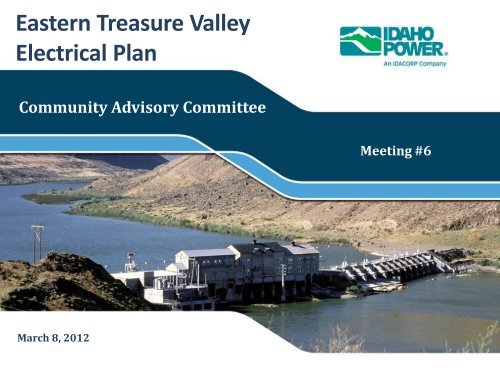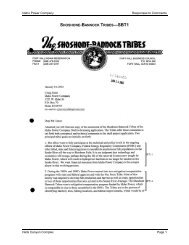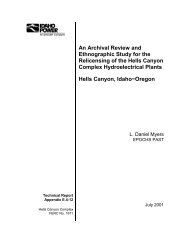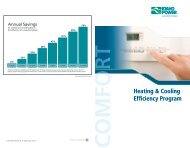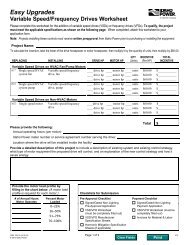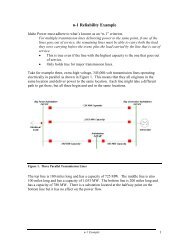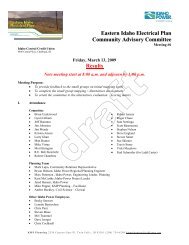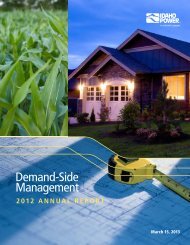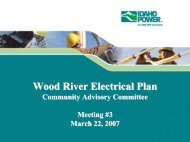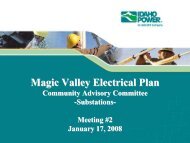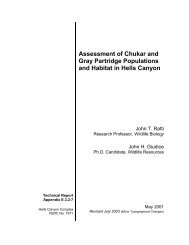Hub Substations - Idaho Power
Hub Substations - Idaho Power
Hub Substations - Idaho Power
- No tags were found...
You also want an ePaper? Increase the reach of your titles
YUMPU automatically turns print PDFs into web optimized ePapers that Google loves.
Eastern Treasure ValleyElectrical PlanCommunity Advisory CommitteeMeeting #6March 8, 2012
Purpose of the Meeting• Continue mapping hub substations and 230 kVtransmission• Begin mapping distribution substations and 138 kVsub-transmissionETVEP Mar20122
Meeting Agenda10:00 a.m. Welcome and Introductions10:15 a.m. Mapping Overview10:30 a.m. Small Groups Mapping Session12:00 p.m. Working Lunch12:30 p.m. Small Groups Mapping Session (Continued)1:30 p.m. Mapping Report-out1:55 p.m. Next Steps and Wrap-up2:00 p.m. AdjournETVEP Mar20123
General Outline October: Initiation, substations, transmission and generation November: Facility tour December: Energy efficiency, pricing and regulatory issues, EasternTreasure Valley existing electrical system conditions, community goals January: Community goals, future electrical buildout needs, transmissionand related components, initial alternatives February: Alternatives development• March: Alternatives development• April: Alternatives evaluation• May: Committee recommendations• June: Review draft plan• September: Possibly reconvene to review draft planETVEP Mar20124
Purpose of the Project• To develop community consensus on the electricalsupply improvements necessary to serve the EasternTreasure Valley in the future. This plan builds upon theresults of the Treasure Valley Electrical Plan.• To develop siting criteria for future electrical facilitysites within the Eastern Treasure Valley.• To use siting criteria to develop community consensusrecommendations for potential electrical facility siteswithin the Eastern Treasure Valley.– The public process is the starting point of all electrical supplyplans and any resulting transmission rights-of-way andsubstation siting requirements.ETVEP Mar20125
ETVEP Mar2012 6
Questions from Meeting #5Q: Can we get TVEP explanations for why they selected proposedsites for both substations and distribution substations?A: The TVEP did not site any distribution substations. They onlysited 500 kV source and 230 kV hub substations. The TVEPCAC followed the criteria they developed and sited the hubsubstations using already existing distribution substationproperties when available or tried to site the substations awayfrom population centers when possible. They also tried to sitethe hub substations near existing 230 kV transmission. TheTVEP CAC sited the source substations as far away frompopulation centers as possible while realizing a number of230 kV transmission lines would need to feed out of thesubstations.ETVEP Mar2012
Q: What hub substation is east of ElmoreCounty? Not evident on map and mayimpact decisions.Justice Substation(Under Construction)MidpointSubstationETVEP Mar2012
Questions from Meeting #5Q: How close can the 230 kV transmission lines be to each other?A: There is a certain amount of spacing that is required betweentransmission lines. Depending on the voltage, the space varies.In general, with a 230 kV line, they have to be a span lengthaway from each other, though sometimes 230 kV lines can bedouble circuited. If the committee would like to do this, pleaseindicate so in the mapping sessions. We will performelectrical studies to see if the system maintains the requiredreliability if certain 230 kV lines are double circuited.ETVEP Mar2012
Questions from Meeting #5Q: Are there reasons a corner is more/less desired than notbeing on a corner for distribution substations?A: Yes. We plan distribution substations to have 8 feeders (13.8kV) fed out of them, two heading each direction. If thesubstation is not on a corner, four feeders will have to be fedeach direction until an intersection is reached. It creates a lotof congestions. Additionally, a distribution substation willneed two 138 kV lines feeding into it so that also adds tocongestion. <strong>Idaho</strong> <strong>Power</strong> prefers street corners for the samereason gas stations do; access to four directions of travel froma single point.ETVEP Mar2012
Orientation to the MappingProcessJared Hansen
4 Step CommitteeMapping Process1. Review hub substation locations designated in TVEP for AdaCounty– Additional capacity will be required in Elmore and Owyhee Counties butmay not require additional hub substations2. Review high voltage transmission line routes to/from hubsubstations for Ada County– 230 kV Transmission3. Site 22 new distribution substations– One in Owyhee County– One in Elmore County– Twenty in Ada County4. Determine 138 kV sub-transmission line routes to existing andnew distribution substationsETVEP Mar201212
Treasure Valley Electrical Plan• The TVEP recommended 7 hub substations in Ada County1. Boise Bench Substation: Already existing hub substation2. Locust Substation: Already existing hub substation3. <strong>Hub</strong>bard Substation: Already existing hub substation4. Cloverdale Substation: Existing distribution substation with<strong>Idaho</strong> <strong>Power</strong> owned land adequate for expansion to hubsubstation5. Highway 16 Substation: New Substation, not sited6. South Boise Substation: New Substation, not sited7. Dry Creek Substation: New Substation. <strong>Idaho</strong> <strong>Power</strong> haspurchased land and will construct first phase in a few yearsHowever, the first phase is to tie in only 138 kV to Dry Creek, not 230 kV.ETVEP Mar201213
Future Hwy 16SubstationFuture Dry CreekSubstationExisting LocustSubstationExisting CloverdaleSubstationExisting <strong>Hub</strong>bardSubstationExistingBoise BenchSubstationFuture South BoiseSubstationETVEP Mar2012
Dry Creek <strong>Hub</strong> SubstationIt may be verydifficult toconnect 230 kVtransmissioninto Dry CreekSubstation dueto landownerissues.Future Dry CreekSubstationETVEP Mar2012
Spring Valley Distribution Subst.Existing SpringValley SubstationAvimoreDevelopmentWe would like toconsider a site ator near theexisting SpringValley Substationas an alternativeto Dry Creek.ETVEP Mar2012
ETVEP Mar2012Existing SpringValley Substation
230 kV vs. 138 kV vs. 69 kV230 kV connects to hub substations<strong>Hub</strong>High voltage<strong>Hub</strong>Transmission138 kV and 69 kV connects distribution substations to hub138 kV and 69 kV connects distribution substations together<strong>Hub</strong>Sub-TransmissionorSub-TransmissionorETVEP Mar201218
Steps 1-2:<strong>Hub</strong> <strong>Substations</strong>• Additional hub capacity is required• Minimum of two 230 kV transmission lines to each hub• Two to four sub-transmission lines (138 kV) out of hub• Confirm TVEP locations or:– Expand existing distribution substation– Locate a new siteETVEP Mar201219
Existing Capacity600 MWExisting Capacity896 MWElmore/ Owyhee Buildout500 MWExisting Capacity300 MWTotal Existing Capacity2096 MWTotal Buildout4000 MWETVEP Mar2012 20Ada Buildout3500 MWExisting Capacity300 MW
Elmore/Owyhee <strong>Hub</strong> OptionsAny or all of the following:1. Upgrade Danskin2. New Station(Anywhere)3. Import <strong>Power</strong>(line from outside area)4. Other Creative OptionsETVEP Mar201221
Legendq%2%2XYXYBPA Substation138kV <strong>Hub</strong>69kV <strong>Hub</strong>138kV Distribution69kV Distribution115kV (BPA)138kV Transmission69kV TransmissionFuture Substation AreaETVEP Mar2012
Legend%2XYXY230kV Station138kV Distribution69kV Distribution138kV TransmissionETVEP Mar201269kV TransmissionFuture Substation Area
Legend%2XYXY230kV Station138kV Distribution69kV Distribution138kV Transmission69kV TransmissionFuture Substation AreaETVEP Mar2012
Magic ValleyElectrical PlanExample<strong>Hub</strong> StationServe with one 138kV line?3 New 80 MWdistribution stationsETVEP Mar201225
Magic ValleyElectrical PlanExample<strong>Hub</strong> StationCommittee added second138kV line to meet theirreliability criteria.The first section of eachline must be overbuiltfrom the <strong>Hub</strong> <strong>Substations</strong>.ETVEP Mar20123 New 80 MWdistribution stations3x80 MW = 240 MWMust use a larger than standard sized wire to get a 240 MWrating. 280 MW is the next size up and is the highest we can go.<strong>Hub</strong> Station26
Mapping Teams
Mapping Process• There are 4 elements that need to be placed– <strong>Hub</strong> <strong>Substations</strong> (230 kV to 138 kV transformation)– 230 kV Transmission– Distribution <strong>Substations</strong> (138 kV to 34.5/12.5 kV transformation)– 138 kV Sub-transmission• The goal for today’s meeting is to,– Complete placing the <strong>Hub</strong> <strong>Substations</strong> and the 230 kV transmissionneeded to interconnect them then– Begin siting the Distribution <strong>Substations</strong> and the 138 kV subtransmissionto interconnect themETVEP Mar201228
Mapping Teams• Divide up into 4 teams– Red, Orange, Green and Blue• Each team will have 2 or 3 <strong>Idaho</strong> <strong>Power</strong>/RBCI people assigned– GIS Operator– Engineer– FacilitatorETVEP Mar201229
Small Group Mapping• Each table will have:– Laminated mapping guide– GIS layer information– Guiding Principals and Community Criteria– Printed maps, stickers and tape to identify potential facilitylocations• Please locate substations to the intersection level• At breaks, it may be helpful to look at maps otherteams are developing– No, it’s not cheating!ETVEP Mar2012
Small Group Mapping• Once you are satisfied with the printed maps, thelocations will be transferred to GIS• Please identify someone on your team to shareperspectives from your group when we reconvene asa large group at 1:30• Don’t forget to refer to the Guiding Principals andCommunity CriteriaETVEP Mar2012
Questions / Next Steps• Advisory Committee Meeting #7 – April 12– Alternatives development and evaluation• Advisory Committee Meeting #8 – May 10– Committee RecommendationsETVEP Mar201232
Thank you for your time andparticipation!ETVEP Mar2012 33


